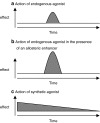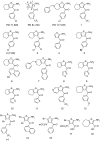Allosteric modulation of adenosine receptors
- PMID: 18615273
- PMCID: PMC2721769
- DOI: 10.1007/s11302-008-9105-3
Allosteric modulation of adenosine receptors
Abstract
Allosteric modulators for adenosine receptors may have potential therapeutic advantage over orthosteric ligands. Allosteric enhancers at the adenosine A(1) receptor have been linked to antiarrhythmic and antilipolytic activity. They may also have therapeutic potential as analgesics and neuroprotective agents. A(3) allosteric enhancers are postulated to be useful against ischemic conditions or as antitumor agents. In this review, we address recent developments regarding the medicinal chemistry of such compounds. Most efforts have been and are directed toward adenosine A(1) and A(3) receptors, whereas limited or no information is available for A(2A) and A(2B) receptors. We also discuss some findings, mostly receptor mutation studies, regarding localization of the allosteric binding sites on the receptors.
Figures







Similar articles
-
Allosteric modulation of adenosine receptors.Biochim Biophys Acta. 2011 May;1808(5):1309-18. doi: 10.1016/j.bbamem.2010.06.013. Epub 2010 Jun 27. Biochim Biophys Acta. 2011. PMID: 20599682 Review.
-
Allosteric modulators for adenosine receptors: an alternative to the orthosteric ligands.Curr Top Med Chem. 2010;10(10):976-92. doi: 10.2174/156802610791293136. Curr Top Med Chem. 2010. PMID: 20370657 Review.
-
Allosteric enhancers of A1 adenosine receptors: state of the art and new horizons for drug development.Curr Med Chem. 2010;17(30):3488-502. doi: 10.2174/092986710792927831. Curr Med Chem. 2010. PMID: 20738250 Review.
-
Allosteric modulation of A1-adenosine receptor: a review.Drug Discov Today Technol. 2013 Summer;10(2):e285-96. doi: 10.1016/j.ddtec.2012.08.005. Drug Discov Today Technol. 2013. PMID: 24050280 Review.
-
A series of 2,4-disubstituted quinolines as a new class of allosteric enhancers of the adenosine A3 receptor.J Med Chem. 2009 Feb 26;52(4):926-31. doi: 10.1021/jm8014052. J Med Chem. 2009. PMID: 19161279
Cited by
-
Ethyl 2-amino-4-methyl-thio-phene-3-carboxyl-ate.IUCrdata. 2021 Apr 9;6(Pt 4):x210351. doi: 10.1107/S2414314621003515. eCollection 2021 Apr. IUCrdata. 2021. PMID: 36339105 Free PMC article.
-
Adenosine A2B Receptor: From Cell Biology to Human Diseases.Front Chem. 2016 Aug 24;4:37. doi: 10.3389/fchem.2016.00037. eCollection 2016. Front Chem. 2016. PMID: 27606311 Free PMC article. Review.
-
Allosteric Modulation of Class A GPCRs: Targets, Agents, and Emerging Concepts.J Med Chem. 2019 Jan 10;62(1):88-127. doi: 10.1021/acs.jmedchem.8b00875. Epub 2018 Aug 28. J Med Chem. 2019. PMID: 30106578 Free PMC article. Review.
-
Effects of adenosine on lymphangiogenesis.PLoS One. 2014 Mar 20;9(3):e92715. doi: 10.1371/journal.pone.0092715. eCollection 2014. PLoS One. 2014. PMID: 24651845 Free PMC article.
-
Adenosine and its receptors as therapeutic targets: An overview.Saudi Pharm J. 2013 Jul;21(3):245-53. doi: 10.1016/j.jsps.2012.05.011. Epub 2012 Jun 23. Saudi Pharm J. 2013. PMID: 23960840 Free PMC article.
References
-
- {'text': '', 'ref_index': 1, 'ids': [{'type': 'PMC', 'value': 'PMC9389454', 'is_inner': False, 'url': 'https://pmc.ncbi.nlm.nih.gov/articles/PMC9389454/'}, {'type': 'PubMed', 'value': '11734617', 'is_inner': True, 'url': 'https://pubmed.ncbi.nlm.nih.gov/11734617/'}]}
- Fredholm BB, IJzerman AP, Jacobson KA, Klotz KN, Linden J (2001) Pharmacol Rev 53:527–552 - PMC - PubMed
-
- {'text': '', 'ref_index': 1, 'ids': [{'type': 'DOI', 'value': '10.1016/S1359-6446(04)03220-9', 'is_inner': False, 'url': 'https://doi.org/10.1016/s1359-6446(04)03220-9'}, {'type': 'PubMed', 'value': '15450241', 'is_inner': True, 'url': 'https://pubmed.ncbi.nlm.nih.gov/15450241/'}]}
- Soudijn W, van Wijngaarden I, IJzerman AP (2004) Allosteric modulation of G protein-coupled receptors: perspectives and recent developments. Drug Discov Today 9:752–758 - PubMed
-
- {'text': '', 'ref_index': 1, 'ids': [{'type': 'PubMed', 'value': '12630295', 'is_inner': True, 'url': 'https://pubmed.ncbi.nlm.nih.gov/12630295/'}]}
- Soudijn W, van Wijngaarden I, IJzerman AP (2002) Allosteric modulation of G protein-coupled receptors. Curr Opin Drug Discov Devel 5:749–755 - PubMed
-
- {'text': '', 'ref_index': 1, 'ids': [{'type': 'DOI', 'value': '10.1146/annurev.pharmtox.47.120505.105159', 'is_inner': False, 'url': 'https://doi.org/10.1146/annurev.pharmtox.47.120505.105159'}, {'type': 'PubMed', 'value': '17009927', 'is_inner': True, 'url': 'https://pubmed.ncbi.nlm.nih.gov/17009927/'}]}
- May LT, Leach K, Sexton PM, Christopoulos A (2007) Allosteric modulation of G protein-coupled receptors. Annu Rev Pharmacol Toxicol 47:1–51 - PubMed
-
- {'text': '', 'ref_index': 1, 'ids': [{'type': 'DOI', 'value': '10.1016/S1359-6446(05)03689-5', 'is_inner': False, 'url': 'https://doi.org/10.1016/s1359-6446(05)03689-5'}, {'type': 'PMC', 'value': 'PMC8607903', 'is_inner': False, 'url': 'https://pmc.ncbi.nlm.nih.gov/articles/PMC8607903/'}, {'type': 'PubMed', 'value': '16580596', 'is_inner': True, 'url': 'https://pubmed.ncbi.nlm.nih.gov/16580596/'}]}
- Gao Z-G, Jacobson KA (2006) Allosterism in membrane receptors. Drug Discov Today 11:191–202 - PMC - PubMed
LinkOut - more resources
Full Text Sources
Other Literature Sources

